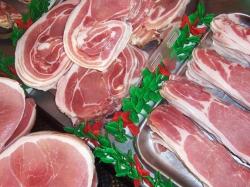Food Inflation Is Here, Mixed Numbers For Proteins
March 3, 2010 | 2 min to read

JPMorgan analyst Charles Grom offers some insight into the world of grocery
stores and food pricing:
Central Theme: Price increases across the board with Kroger leading the way.
In February, Kroger’s average price increased 2.9% over January levels
(following a 1.2% decline from December to January), based on our 31-item
like-kind basket. This month’s increase seems to be in-step with recent
commentary from CEO David Dillon regarding a planned reversal of some
accelerated price investment over time. Importantly, we note that February’s
step-up in price narrows the gap between Kroger and the traditional grocers (SWY,
Harris Teeter) by 160 bps with Kroger now 10% lower, on average. Following
Kroger, the retailer with the 2nd largest price increase this month was
Wal-Mart, who raised prices 1.9% from January to February. All in, Wal-Mart
still holds a very wide lead (15.6%) on the price front versus the grocers,
albeit materially lower than when we started our study last year (January 2009 @
21.1%).
Take #1: Despite moderating deflation, produce prices still declining.
Throughout this deflationary environment, produce categories have delivered
strong tonnage growth as customers have ratcheted up purchase quantities in
response to prices declines. As a result, in February, we believe that food
retailers continued to follow an offensive pricing strategy for produce
potentially opting not to pass inflationary price increases forward to customers
(recall wholesale prices Fruits & Melons, Fresh/Dry Vegs & Nuts rose 13.9% per
January’s PPI release) in hopes to drive traffic into the store. Based on our
proprietary store work, we found that out of 35 produce items across 5 stores (7
identical SKUs per store), only 1 item increased in price, 13 items were priced
in-line with January levels, and 21 items experienced price declines.
Take #2: Protein and dairy pricing remains mixed. While produce prices were
directionally in-line across the 5 stores we visited (generally flat to
declining), other perishable categories didn’t demonstrate similar cohesive
trends. For example, we observed a number different of pricing strategies in
protein (meat, poultry, eggs) and dairy products that seemed to vary by
retailer. To explain, among the 20 total dairy items we checked (4 categories, 5
stores), prices increased on 4 items and decreased on 3 items from January to
February (recall wholesale dairy product prices +5.1% year-over-year in
January). Moreover, out of the 25 protein items we looked at, we observed 9
price hikes and 6 decreases month-over-month (YOY meat, poultry, & fish prices
up 0.9% in January).
To read the rest of this story please go to:
The Business Insider
